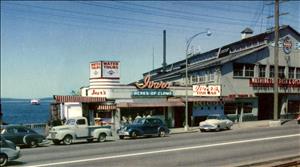In the early 1890s the Seattle waterfront was a mess of small pier sheds and shacks supported on timber quays. But the gold rush of the late 1890s brought prosperity to the waterfront and it was soon rebuilt.
In 1902 the Northern Pacific Railroad built these three piers between the waterfront feet of Madison and University streets. The historical photograph was taken shortly after. The piers were numbered 3 through 5 until World War II when the military renumbered them 54 through 56.
The railroad's first tenants in Pier 3 (now 54) were James Galbraith and Cecil Bacon. They sold hay, feed, and building materials. But soon Pier 3 became the Elliott Bay home port of the "Mosquito Fleet," owned by the Kitsap Transportation Co. (Galbraith's son Walter was a director.) From here little steamers like the Hyak, Kitsap, Reliance, and Utopia steamed away to cross-Sound stops like Indianola, Keyport, and Rolling Bay.
The ocean steamers that slipped from the sides of Pier 4 (now Pier 55, the middle wharf in our scene) usually had steel hulls and their destinations were more romantic: Antwerp; Havre; London; Cork, Ireland; Mexico; and San Francisco.
Still, in 1902 the gilded romance of Alaska seemed even more thrilling, and from Pier 4 the Alaska Commercial Company's steamers Portland, St. Paul, and Bertha carried gold-rush dreamers north to Nome.
Blazoned across Pier 5 (now 56) in this scene is the name Frank Waterhouse. In his day Waterhouse was one of the big names on the waterfront. His steamships were the first to regularly reach the Mediterranean from Puget Sound, the "Mediterranean of the Pacific." Waterhouse also traded with Russia through Vladivistock until the 1917 revolution put a stop to that.
Now Seattle's oldest working waterfront is mostly for playing. One of the first players on this strip of import shops and fish bars was Ivar Haglund who in 1938 opened his little aquarium here on Pier 3 (now 54). In 1946 he opened his Acres of Clams restaurant on Pier 54. When asked how he got his start on the waterfront, Ivar often answered, "Hunger."

